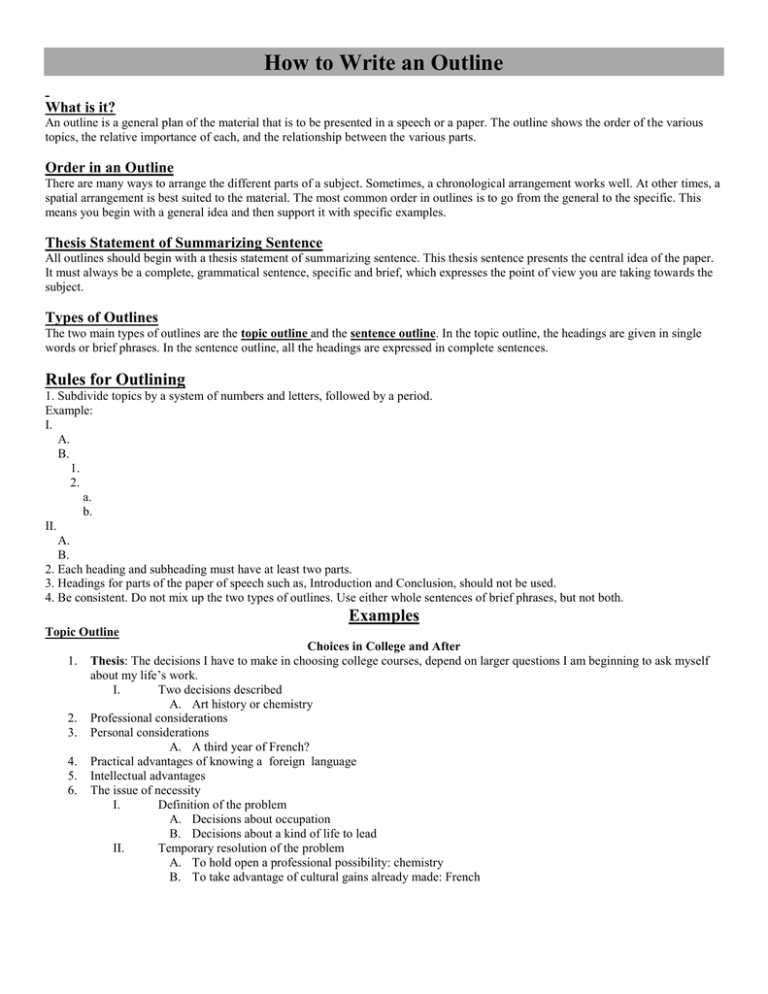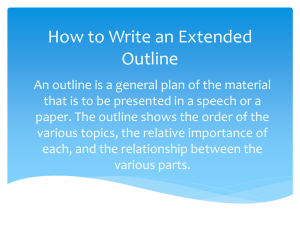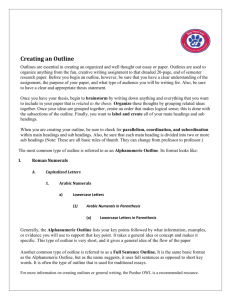How to Write an Outline for "My Community"
advertisement

How to Write an Outline What is it? An outline is a general plan of the material that is to be presented in a speech or a paper. The outline shows the order of the various topics, the relative importance of each, and the relationship between the various parts. Order in an Outline There are many ways to arrange the different parts of a subject. Sometimes, a chronological arrangement works well. At other times, a spatial arrangement is best suited to the material. The most common order in outlines is to go from the general to the specific. This means you begin with a general idea and then support it with specific examples. Thesis Statement of Summarizing Sentence All outlines should begin with a thesis statement of summarizing sentence. This thesis sentence presents the central idea of the paper. It must always be a complete, grammatical sentence, specific and brief, which expresses the point of view you are taking towards the subject. Types of Outlines The two main types of outlines are the topic outline and the sentence outline. In the topic outline, the headings are given in single words or brief phrases. In the sentence outline, all the headings are expressed in complete sentences. Rules for Outlining 1. Subdivide topics by a system of numbers and letters, followed by a period. Example: I. A. B. 1. 2. a. b. II. A. B. 2. Each heading and subheading must have at least two parts. 3. Headings for parts of the paper of speech such as, Introduction and Conclusion, should not be used. 4. Be consistent. Do not mix up the two types of outlines. Use either whole sentences of brief phrases, but not both. Examples Topic Outline 1. 2. 3. 4. 5. 6. Choices in College and After Thesis: The decisions I have to make in choosing college courses, depend on larger questions I am beginning to ask myself about my life’s work. I. Two decisions described A. Art history or chemistry Professional considerations Personal considerations A. A third year of French? Practical advantages of knowing a foreign language Intellectual advantages The issue of necessity I. Definition of the problem A. Decisions about occupation B. Decisions about a kind of life to lead II. Temporary resolution of the problem A. To hold open a professional possibility: chemistry B. To take advantage of cultural gains already made: French Sentence Outline Choices in College and After Thesis: The decisions I have to make in choosing college courses depend on larger questions I am beginning to ask myself about my life’s work. 1. I have two decisions to make with respect to choosing college courses in the immediate future. a. One is whether to elect a course in art history or in chemistry. i. One time in my life, I planned to be a chemical engineer professionally. ii. On the other hand, I enjoy art and plan to travel and see more of it. b. The second decision is whether to continue a third year of French beyond the basic college requirement. i. French might be useful both in engineering and travel. ii. Furthermore, I am eager to read good books which are written in French. iii. How necessary are these considerations in the light of other courses I might take instead? 2. My problem can be put in the form of a dilemma involving larger questions about my whole future. a. On the one hand I want to hold a highly-trained position in a lucrative profession. b. On the other hand I want to lead a certain kind of life, with capacities for values not connected with the making of money. 3. I will have to make a decision balancing the conflicting needs I have described. a. I will hold open the professional possibilities by electing chemistry. b. I will improve and solidify what cultural proficiency in another language I have already gained, by electing French. Specific information for the “My Community” Assignment 1. Begin gathering stories, personality portraits, quotations, and artifacts for this project. 2. In your outline, note where you might include each of your ideas, portraits, conflicts, descriptions, and specific artifacts (pictures, graphs, poems, special quotations, programs, pictures of uniforms or other 3D artifacts, Facebook page). Look at our class website for the list of good questions to ask about your community to help you write your outline. 3. If you wish to use a format other than the usual prose style (journal entry, poetry, etc.), note which format a particular section will take. 4. Your thesis statement should be a general statement that sums up the description of your community and the main ideas you wish to convey about it. You do not have to include this in your final product, but it must appear at the top of your outline and then guide your research and writing. 5. You are writing this as a member of your community, but consider what perspective you want to take – will you insert your opinion throughout the piece or will you try to stay objective? Do you want to include a section that is all about yourself? 6. Think about the patterns of development. I know we are using description, but will a section be a comparison? Classification and division? Cause and effect? Note that in your outline, too. 7. Be sure you address all parts of the prompt: After researching and gathering at least five artifacts on your community, write a multi-genre essay that explains how your community works. What conclusions or implications can you draw? Cite at least five sources, pointing out key elements from each source. L2: In your discussion, address the credibility of each source and origin of sources in view of your research. L3: Identify any gaps or unanswered questions. Include a bibliography.


